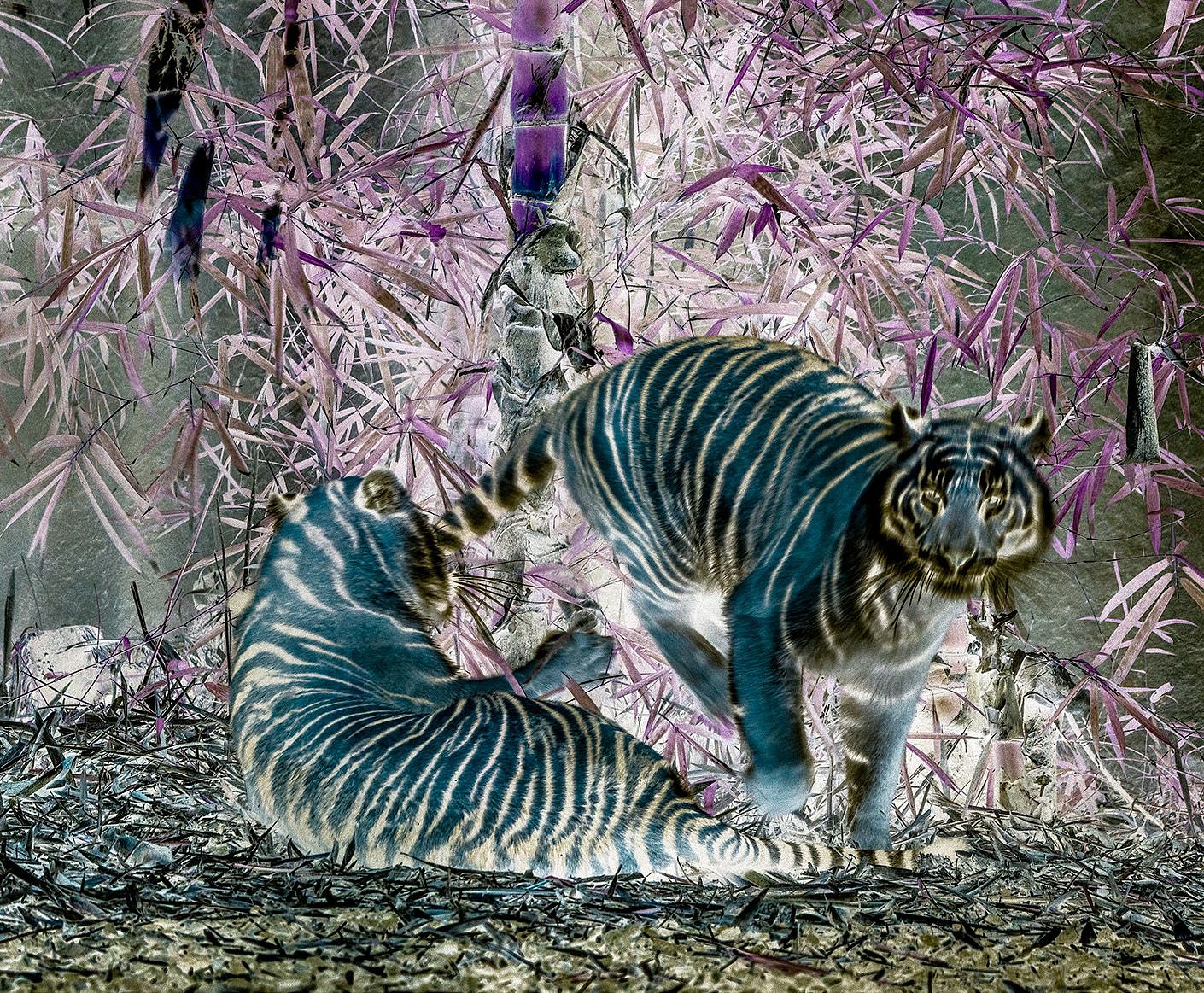PRESS RELEASE

Wild Temper
Dec 20, 2022 – Feb 7, 2023
Wild Temper
Itamar Freed and Kristina Chan
William Morris
Curator: Hadas Glazer
Itamar Freed and Kristina Chan have been working together as a creative duo since 2018. Freed has a background in photography, Chan in printing. Their works deal with the processes that occur in nature and on the relation between culture and nature, depicting images that range from the realistic to the fantastic. On a wide platform in the center of the gallery lies the sculpture Man and Beast by the American glass artist William Morris.
Freed and Chan begin from a photographic viewpoint. Seemingly, their photographs are clear and direct, allowing the eye to recognize the objects it encounters: a tree, tiger, horses, peacock, the jungle – yet in fact, it sees an illusion: the tree isn’t a tree, the jungle isn’t there. The nature appearing before us is a seductive, manipulated and processed image. As in all photography, the occurrences captured by the camera form the basis of the image, yet they also serve as fertile ground for modification and intervention. The photographs on display aren’t a documentation of nature but present an interpretation of representations of nature, the elasticity of the image and the ways in which different cultures approach nature.
The sites and references of the photographs are important for reading the works. They link the dichotomous terms East and West, wild and tamed, balanced and tempestuous. Several of the photographs show remote nature reserves, in which nature runs wild and thick, while others present places in which nature is organized by culture, such as zoos or botanical gardens. The artists rely on traditional Japanese aesthetics, as in the reference to the cherry tree blossom on the almond tree, which became an Israeli symbol. The photographs also refer to iconic European artworks, such as George Stubs large-scale horse painting Whistlejacket, displayed at the National Gallery in London.
The combination of photography methods and experimental printing techniques and the use of varied sources of inspiration create a unique aesthetic. It raises questions on the evolution of the link between cultures and the nature surrounding them and the multifaceted way in which they represent it – radiant, fantastic, mysterious, yet also conquered and tamed. Earthly and transcendental.
Humans are absent from the photographs, yet it is the human point of view that creates them, the power balance and the contradiction in people’s attitude to nature: on the one hand, a yearning and desire to preserve nature; on the other, a will to overcome nature and subject it to human perspectives.
The only human figure in the exhibition appears in William Morris’s Man and Beast. In his work, Morris links together prehistorical, sculptural and museology notions, placing at their foundation themes such as natural cycles, human impulses and spiritual elevation. Morris claims that while a person’s relation to nature is constantly assessed, it nonetheless remains complex and mysterious. The sculpture in the exhibition depicts a mammal and a human skeleton. The animal is created of milky bones whereas the human remains are transparent and clear. The fragile relics evoke an ambiguous narrative, yet the story is obscure: did the man intend to kill the animal but was himself killed instead? Did the animal attack the man before dying from his attempts to protect himself? Perhaps they fed on each other’s body?
Combining the works into one exhibition creates another dimension – existential, energetic, cosmic – a dimension that goes beyond questions of representation, documentation and interpretation; a dimension that seeks to stand in awe before the works, to discover their primal source of energy, to look and contemplate: is that a tree, a tiger, horses, peacock, the jungle? Is that an animal? A person? Human thought, which turns natural forces into symbols, moves beyond the fields of botany and zoology, allowing the gaze to turn and enter.
Wild Temper is an exhibition on duality, one also evoked in its title. The phrase “wild temper” works against our expectations from people: to be civilized, to belong, to accept social conventions – traits that work against untamed, wild nature. A wild temper therefore embodies the nature-culture duality. The various forms of dialogue/contradiction are also expressed by several pairings: Freed and Chan, who together create a unified body of works, the human and the animal in Morris’s sculpture, and the diptychs. Each coupling presents dialogue and tension and thereby conjures thoughts on creating links and contexts, on the dualism and dichotomy implicit in the notions of “nature” and “culture,” and perhaps also the possibility, so glaringly apparent here, of blurring the boundaries between artificial terms.

